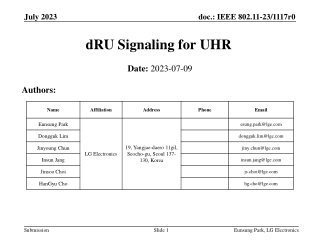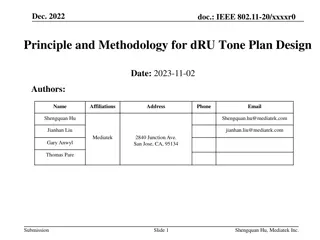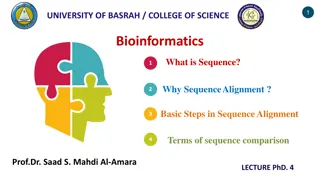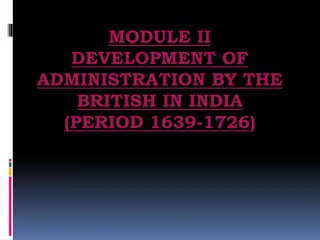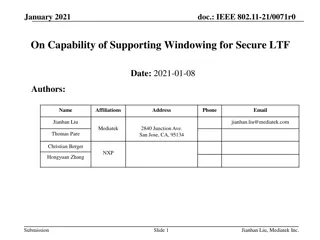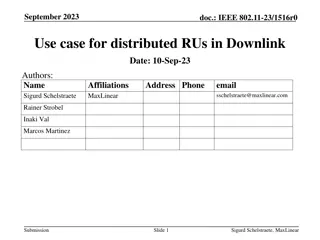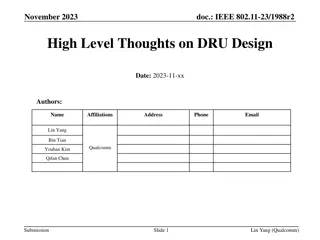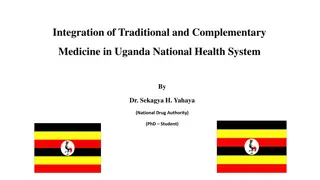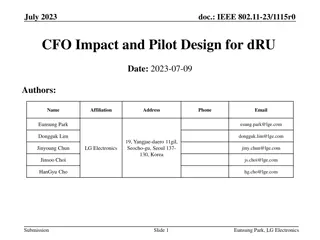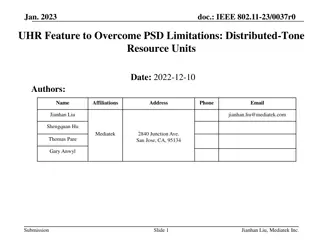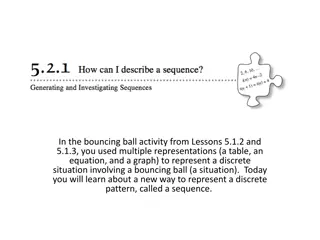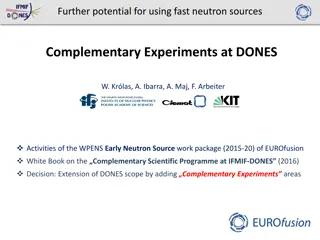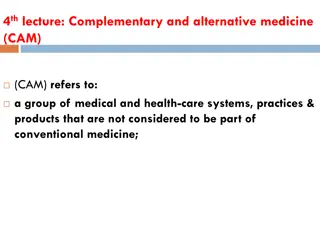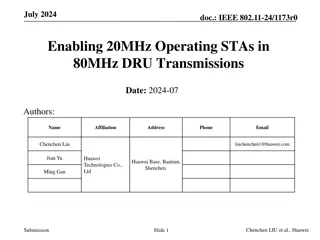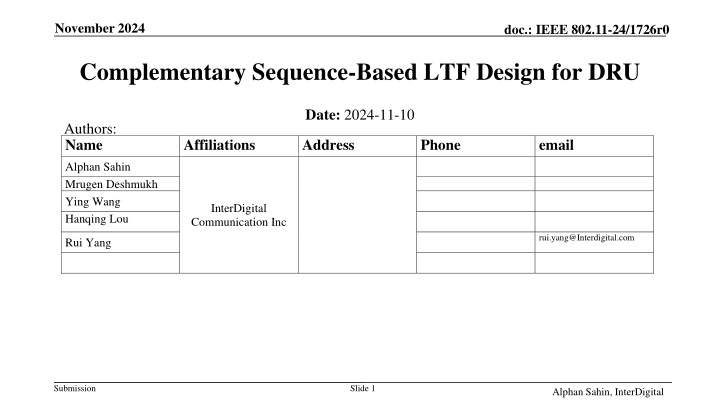
Efficient Design of Complementary Sequence-Based LTF for DRU in UHR
Discover a novel approach for designing low PAPR complementary sequences for DRU in UHR systems, ensuring both theoretical feasibility and practical implementation ease with minimal complexity. Learn about constructing complementary sequences and their significance in optimizing OFDM signals for low PAPR.
Download Presentation

Please find below an Image/Link to download the presentation.
The content on the website is provided AS IS for your information and personal use only. It may not be sold, licensed, or shared on other websites without obtaining consent from the author. If you encounter any issues during the download, it is possible that the publisher has removed the file from their server.
You are allowed to download the files provided on this website for personal or commercial use, subject to the condition that they are used lawfully. All files are the property of their respective owners.
The content on the website is provided AS IS for your information and personal use only. It may not be sold, licensed, or shared on other websites without obtaining consent from the author.
E N D
Presentation Transcript
November 2024 doc.: IEEE 802.11-24/1726r0 Complementary Sequence-Based LTF Design for DRU Date: 2024-11-10 Authors: Name Affiliations Address Phone email Alphan Sahin Mrugen Deshmukh Ying Wang Hanqing Lou InterDigital Communication Inc rui.yang@Interdigital.com Rui Yang Submission Slide 1 Alphan Sahin, InterDigital
November 2024 doc.: IEEE 802.11-24/1726r0 Abstract In this contribution, we propose a complementary sequence (CS) based LTF design for DRU in UHR The proposed approach ensures low PAPR theoretically while allowing low-complexity and low-memory implementation as it constructs the master sequence from seed sequences It is also applicable to signal stream pilots Submission Slide 2 Alphan Sahin, InterDigital
November 2024 doc.: IEEE 802.11-24/1726r0 Representation of Sequences The sequence ? = (?0,?1, ,?? 1) of length ? can be represented with a polynomial as ??? = ?? 1?? 1+ ?? 2?? 2+ + ?0 Some representations: Up-sampling by a factor of ?: ????=? ?{?}? ? ? (?0,0, ,0 ? 1 Zero padding: ??? ??=? (0,0, ,0 ,?1, ,0, ,0 ,?? 1,0, ,0 ) ? 1 ? 1 ,?)? ? zeros Concatenating two sequences: ??? + ??? ??=? (?,?)? An OFDM signal with the symbol duration ?: ??? = ??? ?, 0 ? < ? j2?? ?=e Submission Slide 3 Alphan Sahin, InterDigital
November 2024 doc.: IEEE 802.11-24/1726r0 Complementary Sequences [5] A pair of (?,?) is called a Golay complementary pair (GCP) if 2+ ?2 2, 2+ ??? 2= ?2 ??? ? [0,?) Instantaneous power Complement each other 2+ ?2 2 2+ ??? 2= ?2 ??? OFDM with ?: ??? = ??? ? 2 ??? j2?? ?=e 2 ??? OFDM with ?: ??? = ??? j2?? ? time ? ?=e OFDM symbol duration ? OFDM symbol duration: ? Submission Slide 4 Alphan Sahin, InterDigital
November 2024 doc.: IEEE 802.11-24/1726r0 Complementary Sequences + OFDM = Low PAPR 2= ?2 2, the PAPR of the OFDM symbol using a complementary For ?2 sequence is less than or equal to 2 (i.e., 3 dB) For example, if the sequence elements are QPSK, ?2 2= ?2 2= ? holds 2 2 max ? [0,?)??? ?? ??? max ? [0,?)??? 2+ ?2 ?2 2 ?2 =2? ???? = ?= 2 [3 dB] 2 2 2 ?2 Submission Slide 5 Alphan Sahin, InterDigital
November 2024 doc.: IEEE 802.11-24/1726r0 Constructing Complementary Sequences Let ? and ? be a complementary pair of length ?. Then, a new pair (c, d) can be constructed as ? = ? ? + zeroPad?? ?+1+?( ?{?}) A new pair ??? = ????+ ??????? ?+1+? ??? = ???? ??????? ?+1+? ? = ? ? zeroPad?? ?+1+?( ?{?}) ? ? ? = 4,? = 2,? = 5 ? A great tool to construct low-memory & low-PAPR ( ? ??) UHR LTF for DRUs starting from a seed pair ?: Up sampling yields distributed tones zeroPad?: Zero-padding yields DC tones Submission Slide 6 Alphan Sahin, InterDigital
November 2024 doc.: IEEE 802.11-24/1726r0 Examples for 26-DRUs 20 MHz (1/2) Consider a ? = 13 complementary pair [6]: ? = 1,1,1,1?, 1,1,1, 1?,1, 1,1, 1?,1? , ? = [1,1?, 1, 1, 1,1?, 1,1,1, 1?, 1,1, 1?] Consider the following mappings: tonesDRU26{1} = [-121:9:-13, 5:9:113]; tonesDRU26{2} = [-117:9:-9, 9:9:117]; tonesDRU26{3} = [-119:9:-11, 7:9:115]; tonesDRU26{4} = [-115:9:-7, 11:9:119]; ? 1 ? = 9 ? + zeroPad126( 9{?}) ? = 9 ? zeroPad126( 9{?}) ? = 9 ? + zeroPad126( 9{?}) ? = 9 ? + zeroPad126( 9{?}) As ? and ? are CSs, PAPR 3 dB Note that the sequences ? and ? form a pair, therefore sequences { ?, ?} can be used to construct the sequences for larger DRUs Submission Slide 7 Alphan Sahin, InterDigital
November 2024 doc.: IEEE 802.11-24/1726r0 20 MHz DRU Tone Map and Pilots Data and pilot subcarrier indices for Distributed Tone RUs (DRUs) in a 20 MHz UHR PPDU (Proposed) DRU type DRU index and subcarrier range DRU1 [-121:9:-13, 5:9:113] [-117:9:-9, 9:9:117] DRU6 [-120:9:-12, 6:9:114] [-116:9:-8, 10:9:118] DRU1 26-tone [DRU1, DRU2] DRU3 26-tone [DRU6, DRU7] 106-tone DRU i=1:2 26-tone [DRU1~4], [-4, 3] DRU2 DRU3 DRU4 DRU5 26-tone DRU i=1:9 [-119:9:-11, 7:9:115] DRU8 [-118:9:-10, 8:9:116] [-115:9:-7, 11:9:119] DRU9 [-114:9:-6, 12:9:120] DRU2 26-tone [DRU3, DRU4] DRU4 26-tone [DRU8, DRU9] DRU2 26-tone [DRU6~9], [-3, 4] [-113:9:-5, 13:9:121] DRU7 52-tone DRU i=1:4 DRU1 DRU size Pilot indices for DRU transmission over 20MHz DRU26, ? = {1 9} [-94 32], [-27 90], [-92 34], [-25 92], [-86 40], [-93 33], [-26 91], [-91 35], [-24 93] DRU52, ? = {1,2,3,4} [-67 -49 81 113], [-65 -47 83 115], [-66 -48 82 114], [-64 -46 84 116] DRU106, ? = {1,2} [-103 -58 54 99], [-102 -80 33 114] The 20-MHz tone plan is based on [4] Submission Slide 8 Alphan Sahin, InterDigital
November 2024 doc.: IEEE 802.11-24/1726r0 20 MHz DRU 4xLTF DLTF-122:122 = [0 1 1 1 -1 1 1 -1 1 1 1 1 1 -1 1 1 -1 1 1 1 1 1 -1 1 1 -1 1 1 1i 1i 1i -1i 1i 1i -1i 1i 1i -1 -1 -1 1 -1 -1 1 - 1 -1 1 1 1 -1 1 1 -1 1 1 1 1 1 -1 1 1 -1 1 1 -1i -1i -1i 1i -1i - 1i 1i -1i -1i 1 1 1 -1 1 1 -1 1 1 -1 -1 -1 1 -1 -1 1 -1 -1 1 1 1 -1 1 1 -1 1 1 -1i -1i -1i 1i -1i -1i 1i -1i -1i 1i 1i 1i -1i 1i 1i -1i 1i 1i -1i -1i 0 0 0 0 0 1 1 -1 -1 -1 1 1 1 -1 1 -1 1i 1i 1i - 1i -1i -1i 1i -1i 1i -1i -1i -1i 1i 1i 1i -1i 1i -1i -1 -1 -1 1 1 1 -1 1 -1 1i 1i 1i -1i -1i -1i 1i -1i 1i 1i 1i 1i -1i -1i -1i 1i -1i 1i -1i -1i -1i 1i 1i 1i -1i 1i -1i 1 1 1 -1 -1 -1 1 -1 1 -1i -1i - 1i 1i 1i 1i -1i 1i -1i -1i -1i -1i 1i 1i 1i -1i 1i -1i -1i -1i -1i 1i 1i 1i -1i 1i -1i 1 1 1 -1 -1 -1 1 -1 1 1i 1i 1i -1i -1i -1i 1i - 1i 1i 0] Tone indices The values at the tone indices ? ?a,? ?b,? 1 1 1 1 2 3 (?a,? ?a,?b,? ?b) (?a,? ?a,?b,? ?b) (?a,? ?a,?b,? ?b) 1 -1 1 121:9: 13, 5:9:113 117:9: 9, 9:9:117 119:9: 11, 7:9:115 4 (?a,? ?a,?b,? ?b) -1 1 115:9: 7, 11:9:119 5 (?a,? ?a,?b,? ?b) 1 1 113:9: 5, 13:9:121 6 (?a,? ?a,?b,? ?b) 1 1 120:9: 12, 6:9:114 7 (?a,? ?a,?b,? ?b) 1 -1 116:9: 8, 10:9:118 8 (?a,? ?a,?b,? ?b) -1 -1 118:9: 10, 8:9:116 9 (?a,? ?a,?b,? ?b) (-1i -1i 1 1) 1 -1 114:9: 6, 12:9:120 Extra tones { 4 3 3 4} ?a= 1,1,1,1?, 1,1,1, 1?,1, 1,1, 1?,1? ?b= 1,1?, 1?, 1,1?,1?, 1?,1, 1?, 1?, 1?,1,1? Note that extra tones (i.e., for DRU106) and the single stream pilots will distort the pair in some cases, but their impact on PAPR can be minimized by exhaustive searching Submission Slide 9 Alphan Sahin, InterDigital
November 2024 doc.: IEEE 802.11-24/1726r0 Cubic Metric PAPR and cubic metric (CM) are both metrics used to evaluate the efficiency and quality of signal transmission, especially for OFDM systems CM is a more sophisticated measure introduced by 3GPP, specifically designed to predict power amplifier behavior under non-linear conditions Unlike PAPR, CM takes into account the third-order non-linearity of amplifiers, making it more closely related to actual distortion caused in practical systems CM reflects how much a signal would stress a power amplifier in a real-world scenario. Since it accounts for amplifier non-linearity, it's generally more accurate than PAPR in predicting a signal's impact on amplifier performance CM calculation [3]: 3 ?? =20log10rms ?norm ? ?norm? : Signal in time with the power of 1 1.56 Submission Slide 10 Alphan Sahin, InterDigital
November 2024 doc.: IEEE 802.11-24/1726r0 PAPR and CM Results for 20 MHz DRU LTF PAPR [dB] DRU26 DRU52 DRU106 1 2 3 4 5 6 7 8 9 3.12,3.79 3.29,3.56 3.58,3.67 4.78,4.78 3.8,3.53 2.96,2.97 2.99,3.47 2.79,3.7 3.77,3.72 3.3,3.42 [2] 4.81,4.75 4.85,4.85 4.84,4.76 4.59,4.77 4.8,4.79 PAPR [dB] DRU26 DRU52 DRU106 1 2 3 4 5 6 7 8 9 3.01,3.94 2.96,4.22 3.01,3.94 2.96,4.22 3.01,3.94 3.01,3.94 2.96,4.22 3.01,3.94 2.96,4.22 3.01,4.35 3.01,4.34 3.94,4.65 CS-based 3.01,4.35 3.01,4.34 3.93,4.62 CM [dB] DRU26 DRU52 DRU106 1 2 3 4 5 6 7 8 9 0.85,1.46 1.06,1.22 1.13,1.53 0.91,0.95 0.08,1.04 2.08,1.86 1.67,1.81 0.58,1.3 0.3,1.29 1.44,0.85 1.01,0.93 1.87,2.12 1.95,2.02 [2] 2.01,1.82 2.01,1.89 CM [dB] DRU26 DRU52 DRU106 1 2 3 4 5 6 7 8 9 0.99,1.29 0.93,1.54 0.99,1.29 0.93,1.54 0.99,1.29 0.99,1.29 0.93,1.54 0.99,1.29 0.93,1.54 0.95,1.32 0.95,1.32 1.06,1.73 CS-based 0.95,1.32 0.95,1.32 1.09,1.87 Nss=1&2 Submission Slide 11 Alphan Sahin, InterDigital
November 2024 doc.: IEEE 802.11-24/1726r0 PAPR CDFs for 20 MHz DRU LTF DRU26 DRU52 DRU106 Note: If masked LTF is used, the PAPR of the second SS will be the same as the first SS for all BWs Submission Slide 12 Alphan Sahin, InterDigital
November 2024 doc.: IEEE 802.11-24/1726r0 CM CDFs for 20 MHz DRU LTF DRU26 DRU52 DRU106 Submission Slide 13 Alphan Sahin, InterDigital
November 2024 doc.: IEEE 802.11-24/1726r0 40 MHz DRU Tone Map & Pilots Data and pilot subcarrier indices for Distributed Tone RUs (DRUs) in a 40 MHz UHR TB PPDU DRU index and subcarrier range DRU2 [-233:18:-17, 19:18:235] DRU8 [-236:18:-20, 16:18:232] DRU14 [-234:18:-18, 18:18:234] DRU1 [-242:9:-17, 10:9:235] DRU4 [-236:9:-11, 16:9:241] DRU7 [-239:9:-14, 13:9:238] DRU1 26-tone [DRU1~4], [-8,5] DRU4 26-tone [DRU15~18], [-5,8] DRU1 106-tone [DRU1~2],26-tone DRU5, [-244,-4,3,9] 106-tone [DRU3~4],26-tone DRU14, [-243,-3,4,244] DRU type DRU1 DRU3 DRU4 DRU5 DRU6 [-242:18:-26, 10:18:226] [-238:18:-22, 14:18:230] [-229:18:-13, 23:18:239] [-225:18:-9, 27:18:243] [-240:18:-24, 12:18:228] We use the same tone map in [1] 26-tone DRU i=1:18 DRU7 DRU9 DRU10 DRU11 DRU12 [-231:18:-15, 21:18:237] [-227:18:-11, 25:18:241] [-241:18:-25, 11:18:227] [-232:18:-16, 20:18:236] [-237:18:-21, 15:18:231] DRU13 DRU15 DRU16 DRU17 DRU18 [-228:18:-12, 24:18:240] [-239:18:-23, 13:18:229] [-230:18:-14, 22:18:238] [-235:18:-19, 17:18:233] [-226:18:-10, 26:18:242] DRU2 DRU3 [-238:9:-13, 14:9:239] DRU5 [-241:9:-16, 11:9:236] DRU8 [-235:9:-10, 17:9:242] DRU2 26-tone [DRU6~9], [-6,7] [-240:9:-15, 12:9:237] DRU6 [-237:9:-12, 15:9:240] 52-tone DRU i=1:8 DRU3 26-tone [DRU10~13], [-7,6] 106-tone DRU i=1:4 242-tone DRU i=1:2 DRU2 DRU size Proposed pilot indices for DRU transmission over 40MHz DRU26, ? = {1 18} [-188 64], [ -53 181] [-184 68], [ -49 185] [-171 81] [-186 66] [ -51 183] [-182 70] [ -47 187] [-187 65] [ -52 182] [-183 69] [ -48 186] [-180 72] [-185 67] [ -50 184] [-181 71][ -46 188] DRU52, ? = {1, ,8} [-197 -161 118 181], [-193 -157 122 185] [-195 -159 120 183] [-191 -155 124 187] [-196 -160 119 182] [-192 -156 123 186] [-194 -158 121 184] [-190 -154 125 188] DRU106, ? = {1,2,3,4} [-188 -107 109 199], [-186 -150 111 129], [-187 -106 110 200], [-185 -149 112 130] DRU242, ? = {1,2} [-227 -170 -22 -11 64 140 208 223], [-230 -169 -97 -86 15 65 87 220] Submission Slide 14 Alphan Sahin, InterDigital
November 2024 doc.: IEEE 802.11-24/1726r0 40 MHz DRU 4xLTF Tone indices [-242:18:-26, 10:18:226] [-233:18:-17, 19:18:235] [-238:18:-22, 14:18:230] [-229:18:-13, 23:18:239] [-225:18:-9, 27:18:243] [-240:18:-24, 12:18:228] [-231:18:-15, 21:18:237] [-236:18:-20, 16:18:232] [-227:18:-11, 25:18:241] [-241:18:-25, 11:18:227] The values at the tone indices (?a,? ?a,?b,? ?b) (?a,? ?a,?b,? ?b) (?a,? ?a,?b,? ?b) (?a,? ?a,?b,? ?b) (?a,? ?a,?b,? ?b) (?a,? ?a,?b,? ?b) (?a,? ?a,?b,? ?b) (?a,? ?a,?b,? ?b) (?a,? ?a,?b,? ?b) (?a,? ?a,?b,? ?b) (?a,? ?a,?b,? ?b) (?a,? ?a,?b,? ?b) (?a,? ?a,?b,? ?b) (?a,? ?a,?b,? ?b) (?a,? ?a,?b,? ?b) (?a,? ?a,?b,? ?b) (?a,? ?a,?b,? ?b) (?a,? ?a,?b,? ?b) (-1i -1i -1i 1i 1i 1i 1i -1i) (-1 -1i 1i 1 1i 1i 1i 1i) ? 1 2 3 4 5 6 7 8 9 10 ?a,? 1 1 1 -1 1 1 1 -1 1 1 ?b,? 1 -1 1 1 1i 1 -1 -1 -1 1 DLTF-244:244 = [ ... -1 -1i 1 1 1 -1 1 1 -1 1 1 1 1 1 -1 -1 -1 1 -1 1 1 1 1 -1 1 1 -1 1 1 1 1 1 -1 -1 -1 1 -1 1 1 1 1 -1 1 1 -1 1 1 1 1 1 -1 -1 -1 1 -1 1 1i 1i 1i -1i 1i 1i -1i 1i 1i 1i 1i 1i -1i -1i -1i 1i -1i 1i -1 -1 -1 1 -1 -1 1 -1 -1 -1 - 1 -1 1 1 1 -1 1 -1 1 1 1 -1 1 1 -1 1 1 1 1 1 -1 -1 -1 1 -1 1 1 1 1 -1 1 1 -1 1 1 1 1 1 -1 -1 -1 1 -1 1 -1i -1i -1i 1i -1i -1i 1i -1i -1i -1i -1i - 1i 1i 1i 1i -1i 1i -1i 1 1 1 -1 1 1 -1 1 1 1 1 1 -1 -1 -1 1 -1 1 -1 -1 -1 1 -1 -1 1 -1 -1 -1 -1 -1 1 1 1 -1 1 -1 1 1 1 -1 1 1 -1 1 1 1 1 1 -1 -1 - 1 1 -1 1 -1i -1i -1i 1i -1i -1i 1i -1i -1i -1i -1i -1i 1i 1i 1i -1i 1i -1i 1i 1i 1i -1i 1i 1i -1i 1i 1i 1i 1i 1i -1i -1i -1i 1i -1i 1i -1i -1i -1i 1i 1i 1 0 0 0 0 0 1i 1i 1i 1i 1i -1i 1i -1 -1 -1 1 -1 -1 1 -1 -1 1 1 1 -1 -1 -1 1 -1 -1 1i 1i 1i -1i 1i 1i -1i 1i 1i -1i -1i -1i 1i 1i 1i -1i 1i 1i -1i -1i -1i 1i -1i -1i 1i -1i -1i 1i 1i 1i -1i -1i -1i 1i -1i -1i -1 -1 -1 1 -1 -1 1 -1 -1 1 1 1 -1 -1 -1 1 -1 -1 1i 1i 1i -1i 1i 1i -1i 1i 1i -1i -1i -1i 1i 1i 1i -1i 1i 1i 1i 1i 1i -1i 1i 1i -1i 1i 1i -1i -1i -1i 1i 1i 1i -1i 1i 1i -1i -1i -1i 1i -1i -1i 1i -1i -1i 1i 1i 1i -1i -1i -1i 1i -1i -1i 1 1 1 -1 1 1 -1 1 1 -1 -1 -1 1 1 1 -1 1 1 -1i -1i -1i 1i -1i -1i 1i -1i -1i 1i 1i 1i -1i -1i - 1i 1i -1i -1i -1i -1i -1i 1i -1i -1i 1i -1i -1i 1i 1i 1i -1i -1i -1i 1i -1i - 1i -1i -1i -1i 1i -1i -1i 1i -1i -1i 1i 1i 1i -1i -1i -1i 1i -1i -1i 1 1 1 -1 1 1 -1 1 1 -1 -1 -1 1 1 1 -1 1 1 1i 1i 1i -1i 1i 1i -1i 1i 1i -1i -1i -1i 1i 1i 1i -1i 1i 1i 1i] 11 [-232:18:-16, 20:18:236] 1 -1 12 [-237:18:-21, 15:18:231] 1 1 13 [-228:18:-12, 24:18:240] -1 1 14 [-234:18:-18, 18:18:234] 1 1 15 [-239:18:-23, 13:18:229] -1 -1 16 [-230:18:-14, 22:18:238] -1 1 17 [-235:18:-19, 17:18:233] 1 1 18 [-226:18:-10, 26:18:242] Extra tones: [-8:-5,5:8] Extra tones: [-244 -243 -4 -3 3 4 9 244] -1 1 ?a= 1,1,1,1?, 1,1,1, 1?,1, 1,1, 1?,1? ?b= 1,1?, 1?, 1,1?,1?, 1?,1, 1?, 1?, 1?,1,1? Submission Slide 15 Alphan Sahin, InterDigital
November 2024 doc.: IEEE 802.11-24/1726r0 PAPR and CM Results for 40 MHz DRU 4xLTF PAPR [dB] DRU26 DRU52 DRU106 DRU242 1 2 3 4 5 6 7 8 9 10 11 12 13 14 15 16 17 18 3.26,3.87 3.6,3.89 4.13,4.04 3.8,3.6 3.74,3.87 3.29,3.87 3.9,3.74 3.89,3.13 3.78,3.8 3.72,3.84 3.08,3.52 3.22,3.68 3.85,3.8 3.61,3.73 3.19,3.45 3.85,3.44 3.8,3.79 2.95,3.67 3.68,3.89 3.85,4.01 4.07,4.06 4.05,4.09 4.14,4.11 5.17,4.92 5.23,5.23 5.39,5.39 3.88,3.67 3.55,3.89 3.89,4.03 [2] 5.32,5.08 5.38,5.11 5.47,5.57 PAPR [dB] DRU26 DRU52 DRU106 DRU242 1 2 3 4 5 6 7 8 9 10 11 12 13 14 15 16 17 18 3.01,3.94 2.96,4.22 3.01,3.94 2.96,4.22 3.01,3.94 3.01,3.94 2.96,4.22 3.01,3.94 2.96,4.22 3.01,3.94 2.96,4.22 3.01,3.94 2.96,4.22 3.01,3.94 3.01,3.94 2.96,4.22 3.01,3.94 2.96,4.22 3.01,4.08 3.01,4.08 3.01,4.08 3.01,4.08 3.98,4.69 3.94,4.67 5.1,5.31 CS- based 3.01,4.08 3.01,4.08 3.01,4.08 3.01,4.08 3.98,4.69 3.94,4.67 5.15,5.31 CM [dB] DRU26 DRU52 DRU106 DRU242 1 2 3 4 5 6 7 8 9 10 11 12 13 14 15 16 17 18 0.82,1.32 1.12,1.61 1.23,1.29 1.58,1.54 1.13,0.83 1.42,0.92 1.56,0.8 1.38,1.5 0.94,1.28 0.63,1.32 1.03,0.88 1.1,1.06 1.45,1.19 0.85,1.15 1.15,0.79 1.02,1.45 0.78,1.54 0.87,1.85 1.4,1.37 1.3,1.85 1.47,1.18 1.2,1.8 2.03,1.78 1.94,1.95 2.26,2.24 [2] 1.11,1.79 1.44,1.19 1.08,1.38 1.48,1.31 2.27,1.94 1.97,1.91 2.2,2.13 CM [dB] DRU26 DRU52 DRU106 DRU242 1 2 3 4 5 6 7 8 9 10 11 12 13 14 15 16 17 18 0.99,1.29 0.93,1.54 0.99,1.29 0.93,1.54 0.99,1.29 0.99,1.29 0.93,1.54 0.99,1.29 0.93,1.54 0.99,1.29 0.93,1.54 0.99,1.29 0.93,1.54 0.99,1.29 0.99,1.29 0.93,1.54 0.99,1.29 0.93,1.54 1.28,1.53 1.28,1.53 1.28,1.53 1.28,1.53 0.94,1.58 0.89,1.41 1.89,2.08 CS- based 1.28,1.53 1.28,1.53 1.28,1.53 1.28,1.53 0.94,1.58 0.89,1.41 1.97,2.13 Nss=1&2 Submission Slide 16 Alphan Sahin, InterDigital
November 2024 doc.: IEEE 802.11-24/1726r0 DRU26 DRU52 PAPR CDFs for 40 MHz DRU LTF DRU242 DRU106 Note: If masked LTF is used, the PAPR of the second SS will be the same as the first SS for all BWs Submission Slide 17 Alphan Sahin, InterDigital
November 2024 doc.: IEEE 802.11-24/1726r0 DRU26 DRU52 CM CDFs for 40 MHz DRU LTF DRU242 DRU106 Submission Slide 18 Alphan Sahin, InterDigital
November 2024 doc.: IEEE 802.11-24/1726r0 80 MHz DRU Tone Map Data and pilot subcarrier indices for Distributed Tone RUs (DRUs) in a 80 MHz UHR TB PPDU DRU index and subcarrier range DRU type DRU1 DRU2 DRU3 DRU4 [-483:36:-51, 17:36:449],[-467:36:-35, 33:36:465] [-475:36:-43, 25:36:457],[-459:36:-27, 41:36:473] [-479:36:-47, 21:36:453],[-463:36:-31, 37:36:469] [-471:36:-39, 29:36:461],[-455:36:-23, 45:36:477] We use the same tone map in [1] DRU5 DRU6 DRU7 DRU8 [-477:36:-45, 23:36:455],[-461:36:-29, 39:36:471] [-469:36:-37, 31:36:463],[-453:36:-21, 47:36:479] [-481:36:-49, 19:36:451],[-465:36:-33, 35:36:467] [-473:36:-41, 27:36:459],[-457:36:-25, 43:36:475] 52-tone DRU i=1:16 DRU9 DRU10 DRU11 DRU12 [-482:36:-50, 18:36:450],[-466:36:-34, 34:36:466] [-474:36:-42, 26:36:458],[-458:36:-26, 42:36:474] [-478:36:-46, 22:36:454],[-462:36:-30, 38:36:470] [-470:36:-38, 30:36:462],[-454:36:-22, 46:36:478] DRU13 DRU14 DRU15 DRU16 [-476:36:-44, 24:36:456],[-460:36:-28, 40:36:472] [-468:36:-36, 32:36:464],[-452:36:- 20,48:36:480] [-480:36:-48, 20:36:452],[-464:36:-32, 36:36:468] [-472:36:-40, 28:36:460],[-456:36:-24, 44:36:476] DRU1 DRU2 DRU3 DRU4 52-tone [DRU1~2], [-495, 485] 52-tone [DRU3~4],[-491, 489] 52-tone [DRU5~6],[-489, 491] 52-tone [DRU7~8],[-493, 487] 106-tone DRU i=1:8 DRU5 DRU6 DRU7 DRU8 52-tone [DRU9~10],[-494, 486] 52-tone [DRU11~12],[-490,490] 52-tone [DRU13~14],[-488,492] 52-tone [DRU15~16],[-492,488] DRU1 DRU2 242-tone DRU i=1:4 [-499:4:-19, 17:4:497] [-497:4:-17, 19:4:499] DRU3 DRU4 [-498:4:-18, 18:4:498] [-496:4:-16, 20:4:500] 484-tone DRU i=1:2 DRU1 DRU2 [-499:2:-17, 17:2:499] [-498:2:-16, 18:2:500] Submission Slide 19 Alphan Sahin, InterDigital
November 2024 doc.: IEEE 802.11-24/1726r0 80 MHz DRU Pilots DRU size Proposed pilot indices for DRU transmission over 80MHz [-339 -195 161 305], [-331 -187 169 313], [-335 -191 165 309] [-327 -183 173 317] [-333 -189 167 311] [-325 -181 175 319] [-337 -193 163 307] [-329 -185 171 315] [-338 -194 162 306] [-330 -186 170 314] [-334 -190 166 310] [-326 -182 174 318] [-332 -188 168 312] [-324 -180 176 320] [-336 -192 164 308] [-328 -184 172 316] DRU52, ? = {1, ,16} [-375 -87 69 321], [-427 -103 181 253], [-425 -101 183 255], [-373 -85 71 323], [-374 -86 70 322] [-426 -102 182 254], [-424 -100 184 256], [-372 -84 72 324] DRU106, ? = {1, ,8} [-475 -439 -295 25 41 313 421 457], [-473 -421 -293 -133 27 279 315 475], [-474 -438 -294 26 42 314 422 458], [-472 -420 -292 -132 28 280 316 476] DRU242, ? = {1,2,3,4} [-483 -477 -437 -339 -333 -293 -195 -189 -149 -117 27 125 171 315 413 459] [-482 -476 -436 -338 -332 -292 -194 -188 -148 -116 28 126 172 316 414 460] DRU484, ? = {1,2,3,4} Submission Slide 20 Alphan Sahin, InterDigital
November 2024 doc.: IEEE 802.11-24/1726r0 80 MHz DRU 4xLTF The values at the tone indices (?a,? ?a,?b,? ?b) (?a,? ?a,?b,? ?b) (?a,? ?a,?b,? ?b) (?a,? ?a,?b,? ?b) (?a,? ?a,?b,? ?b) (?a,? ?a,?b,? ?b) (?a,? ?a,?b,? ?b) (?a,? ?a,?b,? ?b) (?a,? ?a,?b,? ?b) (?a,? ?a,?b,? ?b) (?a,? ?a,?b,? ?b) (?a,? ?a,?b,? ?b) (?a,? ?a,?b,? ?b) (?a,? ?a,?b,? ?b) (?a,? ?a,?b,? ?b) (?a,? ?a,?b,? ?b) (?a,? ?a,?b,? ?b) (?a,? ?a,?b,? ?b) The values at the tone indices (?a,? ?a,?b,? ?b) (?a,? ?a,?b,? ?b) (?a,? ?a,?b,? ?b) (?a,? ?a,?b,? ?b) (?a,? ?a,?b,? ?b) (?a,? ?a,?b,? ?b) (?a,? ?a,?b,? ?b) (?a,? ?a,?b,? ?b) (?a,? ?a,?b,? ?b) (?a,? ?a,?b,? ?b) (?a,? ?a,?b,? ?b) (?a,? ?a,?b,? ?b) (?a,? ?a,?b,? ?b) (?a,? ?a,?b,? ?b) (?a,? ?a,?b,? ?b) (?a,? ?a,?b,? ?b) (?a,? ?a,?b,? ?b) (?a,? ?a,?b,? ?b) Tone indices Tone indices ? ? ?a,??b,? ?a,??b,? 1 2 3 4 5 6 7 8 9 19 20 21 22 23 24 25 26 27 28 29 30 31 32 33 34 35 36 1 1 1 -1 1i 1 1 -1 1 -1 -1 1 -1 1i 1 1 1 -1 1 -1 1 1 1 1 -1 -1 -1 -1 1 1 1 -1 1 -1 1 1 1 1 1 -1 1i 1 1 -1 1 1 1 -1 1 -1i -1 -1 -1 1 1 -1 1 1 1 1 -1 -1 -1 1 -1 -1 -1 1 -1 1 -1 -1 [-483:36:-51, 17:36:449] [-467:36:-35, 33:36:465] [-475:36:-43, 25:36:457] [-459:36:-27, 41:36:473] [-451:36:-19 49:36:481] [-479:36:-47, 21:36:453] [-463:36:-31, 37:36:469] [-471:36:-39, 29:36:461] [-455:36:-23, 45:36:477] [-477:36:-45, 23:36:455] [-461:36:-29, 39:36:471] [-469:36:-37, 31:36:463] [-453:36:-21, 47:36:479] [-449:36:-17, 51:36:483] [-481:36:-49, 19:36:451] [-465:36:-33, 35:36:467] [-473:36:-41, 27:36:459] [-457:36:-25, 43:36:475] [-482:36:-50, 18:36:450] [-466:36:-34, 34:36:466] [-474:36:-42, 26:36:458] [-458:36:-26, 42:36:474] [-450:36:-18 50:36:482] [-478:36:-46, 22:36:454] [-462:36:-30, 38:36:470] [-470:36:-38, 30:36:462] [-454:36:-22, 46:36:478] [-476:36:-44, 24:36:456] [-460:36:-28, 40:36:472] [-468:36:-36, 32:36:464] [-452:36:-20, 48:36:480] [-448:36:-16, 52:36:484] [-480:36:-48, 20:36:452] [-464:36:-32, 36:36:468] [-472:36:-40, 28:36:460] [-456:36:-24, 44:36:476] 10 11 12 13 14 15 16 17 18 ?a= 1,1,1,1?, 1,1,1, 1?,1, 1,1, 1?,1? , ?b= 1,1?, 1, 1, 1,1?, 1,1,1, 1?, 1,1, 1? Extra tones [-495 485 -491 489 -489 491 -493 487 -494 486 -490 490 -488 492 -492 488] Extra tones [-499 -487 493 497 -497 -485 495 499 -498 -486 494 498 -496 -484 496 500] [1 -1 -1 -1 1 1 1 -1 1 -1 -1 -1 -1 -1 -1 1] [1 1 1 -1 1 -1 -1 -1 1 1 1 -1 -1 1 1 1] Submission Slide 21 Alphan Sahin, InterDigital
November 2024 doc.: IEEE 802.11-24/1726r0 80 MHz DRU 4xLTF DLTF-500:500 = [ ... 0 1 1 1 -1 1 1 1 -1 -1 -1 1 -1 1 1 -1 1 1 1 1 -1 1 1 -1 1 1 1 1 -1 -1 -1 1 -1 1 1 1 -1 1 1 -1 1 -1 -1 -1 1 1 1 -1 1 1i 1i 1i -1i 1 1 1 -1 1 1 -1 1 1 1 1 - 1 -1 -1 1 -1 1 1 1 -1 1 1 -1 1 -1 -1 -1 1 1 1 -1 1 1i 1i 1i -1i 1 1 1 -1 1 1 -1 1 1 1 1 -1 -1 -1 1 -1 1 1 1 -1 1 1 -1 1 -1 -1 -1 1 1 1 -1 1 1i 1i 1i -1i 1i 1i 1i -1i 1i 1i -1i 1i 1i 1i 1i -1i -1i -1i 1i -1i 1i 1i 1i -1i 1i 1i -1i 1i -1i -1i -1i 1i 1i 1i -1i 1i -1 -1 -1 1 -1 -1 -1 1 -1 -1 1 -1 -1 -1 -1 1 1 1 -1 1 -1 - 1 -1 1 -1 -1 1 -1 1 1 1 -1 -1 -1 1 -1 -1i -1i -1i 1i 1 1 1 -1 1 1 -1 1 1 1 1 -1 -1 -1 1 -1 1 1 1 -1 1 1 -1 1 -1 -1 -1 1 1 1 -1 1 1i 1i 1i -1i 1 1 1 -1 1 1 - 1 1 1 1 1 -1 -1 -1 1 -1 1 1 1 -1 1 1 -1 1 -1 -1 -1 1 1 1 -1 1 1i 1i 1i -1i -1i -1i -1i 1i -1i -1i 1i -1i -1i -1i -1i 1i 1i 1i -1i 1i -1i -1i -1i 1i -1i -1i 1i - 1i 1i 1i 1i -1i -1i -1i 1i -1i 1 1 1 -1 1 1 1 -1 1 1 -1 1 1 1 1 -1 -1 -1 1 -1 1 1 1 -1 1 1 -1 1 -1 -1 -1 1 1 1 -1 1 1i 1i 1i -1i -1 -1 -1 1 -1 -1 1 -1 -1 -1 - 1 1 1 1 -1 1 -1 -1 -1 1 -1 -1 1 -1 1 1 1 -1 -1 -1 1 -1 -1i -1i -1i 1i 1 1 1 -1 1 1 -1 1 1 1 1 -1 -1 -1 1 -1 1 1 1 -1 1 1 -1 1 -1 -1 -1 1 1 1 -1 1 1i 1i 1i - 1i -1i -1i -1i 1i -1i -1i 1i -1i -1i -1i -1i 1i 1i 1i -1i 1i -1i -1i -1i 1i -1i -1i 1i -1i 1i 1i 1i -1i -1i -1i 1i -1i 1 1 1 -1 1i 1i 1i -1i 1i 1i -1i 1i 1i 1i 1i - 1i -1i -1i 1i -1i 1i 1i 1i -1i 1i 1i -1i 1i -1i -1i -1i 1i 1i 1i -1i 1i -1 -1 -1 1 0 0 0 0 0 0 0 0 0 0 0 0 0 0 0 0 0 0 0 0 0 0 0 0 0 0 0 0 0 0 0 0 1 1 1 -1 1 1 -1 1 1 1 1 -1 -1 -1 1 -1 -1 -1 -1 1 -1 -1 1 -1 1 1 1 -1 -1 -1 1 -1 1 1 -1 1 1i 1i 1i -1i 1i 1i -1i 1i 1i 1i 1i -1i -1i -1i 1i -1i -1i -1i -1i 1i -1i -1i 1i - 1i 1i 1i 1i -1i -1i -1i 1i -1i 1i 1i -1i 1i -1 -1 -1 1 -1 -1 1 -1 -1 -1 -1 1 1 1 -1 1 1 1 1 -1 1 1 -1 1 -1 -1 -1 1 1 1 -1 1 -1 -1 1 -1 -1 -1 -1 1 -1 -1 1 -1 - 1 -1 -1 1 1 1 -1 1 1 1 1 -1 1 1 -1 1 -1 -1 -1 1 1 1 -1 1 -1 -1 1 -1 -1 -1 -1 1 -1 -1 1 -1 -1 -1 -1 1 1 1 -1 1 1 1 1 -1 1 1 -1 1 -1 -1 -1 1 1 1 -1 1 -1 -1 1 -1 1i 1i 1i -1i 1i 1i -1i 1i 1i 1i 1i -1i -1i -1i 1i -1i -1i -1i -1i 1i -1i -1i 1i -1i 1i 1i 1i -1i -1i -1i 1i -1i 1i 1i -1i 1i -1 -1 -1 1 -1 -1 1 -1 -1 -1 -1 1 1 1 -1 1 1 1 1 -1 1 1 -1 1 -1 -1 -1 1 1 1 -1 1 -1 -1 1 -1 1 1 1 -1 1 1 -1 1 1 1 1 -1 -1 -1 1 -1 -1 -1 -1 1 -1 -1 1 -1 1 1 1 -1 -1 -1 1 -1 1 1 -1 1 1 1 1 - 1 1 1 -1 1 1 1 1 -1 -1 -1 1 -1 -1 -1 -1 1 -1 -1 1 -1 1 1 1 -1 -1 -1 1 -1 1 1 -1 1 -1i -1i -1i 1i -1i -1i 1i -1i -1i -1i -1i 1i 1i 1i -1i 1i 1i 1i 1i -1i 1i 1i - 1i 1i -1i -1i -1i 1i 1i 1i -1i 1i -1i -1i 1i -1i -1 -1 -1 1 -1 -1 1 -1 -1 -1 -1 1 1 1 -1 1 1 1 1 -1 1 1 -1 1 -1 -1 -1 1 1 1 -1 1 -1 -1 1 -1 1 1 1 -1 1 1 -1 1 1 1 1 -1 -1 -1 1 -1 -1 -1 -1 1 -1 -1 1 -1 1 1 1 -1 -1 -1 1 -1 1 1 -1 1 -1i -1i -1i 1i -1i -1i 1i -1i -1i -1i -1i 1i 1i 1i -1i 1i 1i 1i 1i -1i 1i 1i -1i 1i -1i - 1i -1i 1i 1i 1i -1i 1i -1i -1i 1i -1i -1 -1 -1 1 -1 -1 1 -1 1 1 -1 1 -1 -1 -1 1] Submission Slide 22 Alphan Sahin, InterDigital
November 2024 doc.: IEEE 802.11-24/1726r0 PAPR and CM Results for 80 MHz DRU 4xLTF PAPR [dB] DRU52 DRU106 DRU242 DRU484 1 2 3 4 5 6 7 8 9 10 11 12 13 14 15 16 5.01,5.01 4.4,4.49 5.13,4.87 4.98,5.19 5.15,5.09 5.52,5.11 4.9,4.9 4.91,4.94 4.68,4.2 5,4.92 4.7,4.99 4.97,5.04 4.89,4.92 5.08,5.09 5.08,5.08 4.93,5.12 4.97,5.02 5.31,5.15 4.86,5.13 5.31,5.38 5.5,5.41 5.28,4.6 [2] 5.1,5.12 5.07,5.2 5.03,5.07 5.07,5.15 5.18,5.17 5.26,5.42 5.36,5.16 5.49,5.42 PAPR [dB] DRU52 DRU106 DRU242 DRU484 1 2 3 4 5 6 7 8 9 10 11 12 13 14 15 16 3.01,4.8 3.01,4.75 3.01,4.8 3.01,4.75 3.01,4.8 3.01,4.75 3.01,4.8 3.01,4.75 3.01,4.8 3.01,4.75 3.01,4.8 3.01,4.75 3.01,4.8 3.01,4.75 3.01,4.8 3.01,4.75 CS 3.8,4.64 3.84,4.71 3.84,4.71 3.8,4.64 3.8,4.64 3.84,4.71 3.84,4.71 3.8,4.64 5.05,4.99 5.33,5.15 5.05,4.99 5.33,5.15 based 5.24,5.35 5.24,5.35 CM [dB] DRU52 DRU106 DRU242 DRU484 1 2 3 4 5 6 7 8 9 10 11 12 13 14 15 16 1.88,1.94 1.58,1.55 2.09,1.78 2.16,2.11 2.1,2.22 2.06,2.01 2.06,2.01 1.67,1.76 1.32,1.3 1.79,1.78 1.57,2 2.03,1.87 2.09,1.79 1.67 2.19,2.12 2.12,2 2.11,2.19 1.89,2.09 2.22,2.17 2.05,1.48 1.89 2.36,2.32 2.38,2.27 [2] 1.84,1.81 1.89,1.8 1.76 1.80 2.28,2.11 2.33,2.16 2.06,2.19 CM [dB] DRU52 DRU106 DRU242 DRU484 1 2 3 4 5 6 7 8 9 10 11 12 13 14 15 16 0.97,1.61 0.97,1.61 0.97,1.61 0.97,1.61 0.97,1.61 0.97,1.61 0.97,1.61 0.97,1.61 0.97,1.61 0.97,1.61 0.97,1.61 0.97,1.61 0.97,1.61 0.97,1.61 0.97,1.61 0.97,1.61 1.03,1.57 1.04,1.65 1.04,1.65 1.03,1.57 1.73,1.97 1.81,2.07 1.84,2.15 CS 1.04 1.65 1.03 1.57 based 1.73,1.97 1.81,2.07 1.84,2.15 Submission Slide 23 Alphan Sahin, InterDigital
November 2024 doc.: IEEE 802.11-24/1726r0 DRU52 DRU106 PAPR CDFs for 80 MHz DRU LTF DRU242 DRU484 Note: If masked LTF is used, the PAPR of the second SS will be the same as the first SS for all BWs Submission Slide 24 Alphan Sahin, InterDigital
November 2024 doc.: IEEE 802.11-24/1726r0 DRU52 DRU106 CM CDFs for 80 MHz DRU LTF DRU484 DRU242 Submission Slide 25 Alphan Sahin, InterDigital
November 2024 doc.: IEEE 802.11-24/1726r0 Conclusions The proposed approach constructs the master sequences for 20/40/80 MHz based on two seed sequences Enables low-memory implementation The approach is scalable as it uses the variants of the same seed sequence for 20/40/80 MHz It ensures low-PAPR theoretically without sequence search It is applicable to signal stream pilots Submission Slide 26 Alphan Sahin, InterDigital
November 2024 doc.: IEEE 802.11-24/1726r0 SP Do you agree that the DRU LTF sequences can be QPSK modulated? Submission Slide 27 Alphan Sahin, InterDigital
November 2024 doc.: IEEE 802.11-24/1726r0 References [1] 11/24-0468r2 DRU Tone Plan for 11bn [2] 11-24-1567r0 LTF Design or DRU [3] R1-163437, Ericsson, Nokia, Lenovo, LG, and ZTE, WF on DMRS multi-tone evaluation methods, Apr. 2016. [4] 11-24-1712r0 DRU Tone Plan for 20 MHz Distribution Bandwidth [5] Parker, M.G., Paterson, K.G. and Tellambura, C. Golay Complementary Sequences. In Wiley Encyclopedia of Telecommunications, J.G. Proakis (Ed.), 2003, https://doi.org/10.1002/0471219282.eot367 [6] W. H. Holzmann, H. Kharagani, A Computer Search for Complex Golay Sequences , Australasian Journal of Combinatorics, pp.251-258, 10 (1994) 4,10 Submission Slide 28 Alphan Sahin, InterDigital

